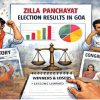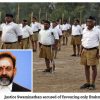Goa is abuzz with excitement as vintage bike and car owners, users, collectors and fans are decking […]

GODI MEDIA DISTORTED RIOTS! BY PAMELA PHILIPOSE
July 09 - July 15 2022 July 8, 2022HORROR: The most terrible incident during the anti-Godhra riots was the burning of the Muslim-owned Best Bakery along with the residents including, children working there.
By Pamela Philipose
The ombudsperson of The Wire has pointed out how the godi media supporters of the BJP government led by Narendra Modi have distorted and buried the horrific slaughter of the minority Muslim community post-Godhra incident.
The 2002 Gujarat pogrom has today been consigned to a zone of media manufactured silence. The horror, the sheer horror, of those events ranging from the Godhra train burning to the open butchery that raged for days on the streets of Gujarat, may as well have happened in another country. At that time we had imagined that generations of Indians would look back on those dark developments and shudder, swearing that they would never allow such a cursed spell to befall the country again. Yet, here we are at a point where, as The Wire piece (‘As Truth-Tellers Get Arrested, We Must Tell Our Children the Truth’, June 30) tells us, an 18 year old who had studied all her life in a well-known school in the National Capital Region, had “no idea..about the Gujarat pogrom of 2002”.
How did this come about? And what are the consequences of such forgetting? The second question I will come to a little later, as for the first there can be no getting away from the fact that the media in the country have played a major role in achieving what could be termed as a deliberately manufactured amnesia about this pogrom. This, despite it having been the country’s first communally driven mass massacre in the age of television.
The media management of the genocide and post-genocide narratives by the political establishment under Narendra Modi as chief minister of Gujarat, was central. While researching for my 2019 book, Media’s Shifting Terrain, I referenced Modi’s first televised address on the Gujarat developments over Doordarshan on February 28, 2002. Even though the state was in flames, he dwelt only on the Godhra train burning, stating that “Gujarat shall not tolerate any such incident. The culprits will get full punishment for their sins. Not only this, we will set an example that nobody, not even in his dreams thinks of committing a heinous crime like this”. All government briefings thereafter followed this pattern: while Godhra incident was termed an “inhuman genocide”/ “inhuman carnage”/“massacre”; the communal riots were termed as “disturbances” and, sometimes, “violent disturbances/incidents”.
The Gujarat government even laid the riots at the door of the national media, arguing before the National Human Rights Commission that “on account of widespread reporting both in the visual as well as the electronic media, incidents of violence on a large scale started occurring in Ahmedabad (and) Baroda cities and some towns of Panchmahals, Sabarkantha, Mehsana, etc.” The commentary of newspapers like Gujarat Samachar, Sandesh et al, that justified and normalised the violence, was pitted by the ruling dispensation against the severely critical “national media”. While the former’s reports were deemed authentic, the latter was bestowed the title of being a “secular Taliban”.
But it is the taming of this once reviled “national media” that constitutes the more significant aspect of this saga. A combination of interlocking interventions by the Modi government were employed to achieve this, from forging relationships of mutual advantage with media proprietors and the hiring of public relations firms, to severely punishing those entities and individuals that persisted in remaining critical to chief minister (and later prime minister), by withholding governmental access and launching tax inquiries. Meanwhile social media tools were harnessed to project Modi as a figure engaging continuously with the people even while ensuring that he did not have to subject himself to the intrusive questioning of mainstream media interlocutors with their inevitable references to unanswered questions linked to a violent past.
A blog, ‘Letter to my countrymen’, for instance, appeared on his website in 2010 at the point when he was to appear before the Special Investigative Team (SIT) set up by the Supreme Court. Written in order to exonerate himself before the public, he accused vested interests of coming together to spread lies, adding that the machination will come unstuck, “for people have seen through this charade”. On December 26, 2013, when Zakia Jafri’s petition against him in the Gulberg Society case was dismissed by a metropolitan court in Ahmedabad, he tweeted, ‘Satyamev Jayate! Truth alone triumphs’, making a similar claim of exoneration.
As his political persona grew, fuelled by a series of electoral victories – three as Gujarat chief minister and two as the prime minister of India – the media became more than willing to airbrush the Gujarat pogrom out of the frame. In my book I cited cover headlines of India Today to make this point – its March 18, 2002 cover bore the words, ‘Agony of Gujarat: Blundering Modi’ (March 18); by November 5, 2012, the magazine was proclaiming, ‘King Modi Seeks Delhi Throne’ (November 5, 2012) and the May 26, 2014 issue showed him striking a Napoleanesque pose under the banner, ‘The Conqueror’.
Now to the second question: What are the consequences of a deliberate forgetting created by media coverage? The most obvious and disturbing of course is the diminishing of India as a democracy and as a society committed to justice. The recent brutal treatment accorded to civil society activist and journalist Teesta Setalvad by the Gujarat police (‘A First Person Account of Teesta Setalvad’s Arrest by the Gujarat ATS’, June 28), seizing upon the Supreme Court verdict in Zakia Ahsan Jafri vs State of Gujarat & Anr which saw her involvement in the case as “abuse of process” and went on to say “all those involved in such abuse of process, need to be in the dock and proceeded with in accordance with law”, indicates an abject failure to achieve justice, not once but twice over. Justice is being denied to a human rights defender who was only seeking justice for those who had been savagely dispossessed of the right to life in 2002.
The anguish of a respected judge of the Supreme Court over this turn of events comes through in a piece he wrote for The Wire (‘Condemned by Innuendo: Some Questions on the SC Order That Led to Teesta Setalvad’s Arrest’, June 28). He almost cannot bring himself to believe that the highest court in the land would suggest the arrest of Setalvad:
“Did the Supreme Court suggest Teesta’s arrest?
“If so, then the learned judges suggested the arrest of a person who was not really recognised as a party to the proceedings and who was not heard and whose liberty was taken away unilaterally and arbitrarily. Surely, the Supreme Court could not have suggested that a stranger to the proceedings before it…should be arrested for whatever reason.
“However, if I am wrong in my assessment and the Supreme Court did intend or suggest Teesta’s arrest, heaven help us, please.”
Setalvad had almost anticipated this moment. Referring to her decision to follow up on this case, she writes, “It was time to test the criminal justice system from several angles; can justice ever be done when mass violence happens? Can our courts restore the faith in the system
The savage murder of a tailor in Udaipur for supporting Nupur Sharma by two young Muslim men will continue to haunt the country well into the foreseeable future. Despite the prompt and unequivocal condemnation of the crime by Muslim groups and individuals across the country, the Hindutva lobby has already made its moves to weaponise the crime for their prime political purposes of social polarisation, driving fear of the Muslim into the mind of the average citizen, most specifically, among Hindus.
Even in this moment that called for people uniting against the rising tide of communal violence in the country, Big Media lost little time in shoring up the hate quotient. In a thrice they came up with the labels they use to excoriate those who speak up for human rights and media freedoms. One TV channel, for instance, is obsessed with an entity they label ‘The Lobby’. The headlines for their chat shows keep referencing the “lobby”, as it once did the ‘Tukde tukde gang’. In the wake of the Udaipur atrocity it time and again put out its old chestnut: “Is the Lobby selectively emboldening Radicals?” “Lobby dogwhistles to blame?”
There is no intent here to try an ensure peace and social unity. The aim instead is to use each incident like this to shore up the large ‘Hinduism in danger’ narrative. Interestingly, even if the murder was not a “beheading”, whatever the intentions of the barbarians behind it might have been, many news channels persisted with the term possibly because it suited their narrative of the “Jehadi John” type of Islamic terrorist at the door.
What this latest outrage indicates is the wisdom of the words: ‘The evil that men do lives after them’. Not many in the media seemed to remember in the general distress caused by the gruesome Udaipur murder, the horrific incident rife with communal hatred that took place over four years earlier in this very same state and region, when one Shambhulal Regar, killed Mohammed Bhatta Sheikh, a labourer from West Bengal, and got his young nephew to film it on his phone. The evil men do does indeed live on after they have been locked up, often in a sickeningly repetitive, almost copycat, fashion as the latest atrocity shows.
Fact-checking the Zubair arrest
It is unsurprising that several journalist bodies, from the Editors Guild to the International Press Institute, have issued statements condemning the arrest of Mohammed Zubair by the Delhi Police (‘Assault on Truth’: Journalists, Politicians Mince No Words in Condemning Zubair’s Arrest’, June 28). This is public recognition of the invaluable labour that Zubair and colleague Pratik Sinha, founder editors of AltNews, have been doing since February 2017, by setting up a fact-finding website that “speaks truth to power and is free of corporate and political control”. Both Zubair and Sinha have over a period of time developed digital tools and methodologies to help them achieve what may often seem a Sisyphean task of checking the gross informational abuses and biases that have come to mark society today.
This simple act of fact checking has hit the authoritarian political establishment and its ideological progenitor, the Sangh parivar, where it hurts and the Zubair arrest is only more evidence of this, Meanwhile Big Media is busy pouring slush over Zubair’s reputation true to their slavish record. Newslaundry did an excellent summary. It cited India Today’s story that Zubair had received more than 50 lakh over the last three months, attributed to “source”, which turns out to be the very same Delhi Police now in the hunt for his scalp.
As international observers have commented, journalists should not be jailed for “what they write or tweet, or say”, because it is their job to do so. The fact is that the repression that Zubair’s sharp observations – packaged in 280-character texts, often accompanied by extremely apt images – have invited indicates in an inverted way their authenticity.
The Wire’s investigation into the anonymous tweet that the Delhi Police used to frame their case is of great significance for any notion of digital democracy (‘Anonymous Complainant Targeting Zubair Tweet Linked to Tek Fog App, BJYM Leader in Gujarat’, July 2). The persistent digging unearthed the usual suspects behind the tweet, a range of them in fact, from Vikash Ahir, state president of the Hindu Yuva Vahini (HYV) and co-convenor of the Bharatiya Janata Yuva Morcha (BJYM) in Gujarat, to a network of 757 accounts linked to him which have “attempted – since 2018 – to incriminate the fact-checker alongside Pratik Sinha, co-founder at AltNews, by highlighting and misconstruing old tweets uploaded by the two journalists to portray them as ‘Hinduphobic’ and then tagging the local authorities in order to have them arrested”. It was the job of the Delhi Police to do such due diligence before they arrested Zubair, but that I suppose is too much to expect from this political tool of the ruling government at the Centre. As for Big Media, with the exception of The Indian Express, they played a wait-and-watch game, as the Zoo-bear was baited.
The repression against Zubair also indicates how this country is declining into a land worthy of pure caricature, where Keystone Kops dig out improbable evidence in order to stomp over constitutional guarantees and magistrates nod over bail applications. This is why I found the The Wire’s coverage of the Zubair “capture” by the Delhi Police relevant. Not only did it provide the material evidence that indicated that each of Zubair’s tweets has been unquestionably fact-based (‘Kissi Se Na Kehna! Mohammed Zubair Arrested for Tweeting Photo from 1983 Hindi Film’, June 28), it carried parodies that should be read by everyone in today’s day and age (‘Delhi Police Must Conduct a Seance to Help Unravel the Honeymoon Conspiracy’, June 29). The idea of the Delhi Police filing an FIR on the long dead Hrishikesh Mukherjee for daring to insult divinities (‘Hrishikesh Mukherjee Must Thank His Lucky Stars for Escaping the Delhi Police’s Grasp’, June 30) should provide us some humour to navigate these menacing times.
Where in the Constitution are demolitions permitted? Is India following the Israeli model? If someone indulges in violence during protests, they should be punished after due process, but how can a home of a protestor – built with hard work and painful savings – be demolished in revenge by the state?
If damage to public property is unacceptable, so to is the destruction of private property. The Courts need to be reminded that peaceful protests are part of constitutional rights, punishing protestors by illegal demolitions is a blot on Indian democracy.”
Courtesy: the Wire














